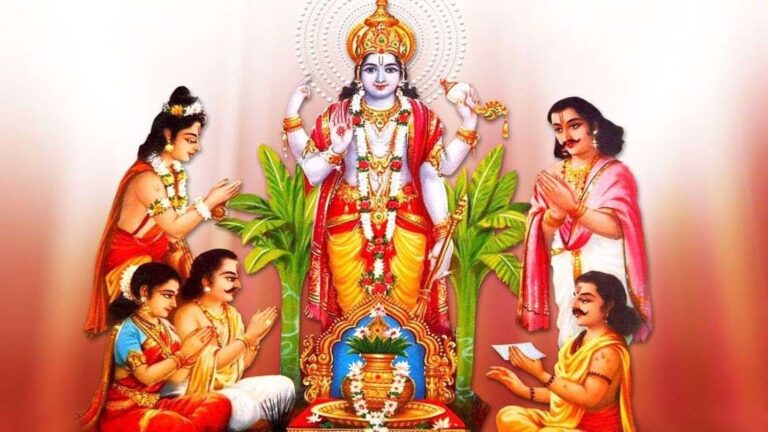Sri Satyanarayana Puja
- India’s diverse religions, customs, and traditions enrich the country. Hindus enthusiastically worship various deities according to the festival calendar. Each pooja is represented by a different name and has its own meaning.
- On any given occasion, every Hindu performs Satyanarayana puja in their home.
- In this article, I try to emphasize the benefits and significance of performing Satyanarayana puja.
- Sri Satyanarayana is regarded as one of Lord Vishnu’s names. When we look at the phrase Satyanarayan, the first term Satya stands for truth, and the second term Narayana means the Supreme.
- As a result, Satya Narayana is regarded as an embodiment of truth. He manifested himself on the Ratnagiri Hills in Annavaram in a unique form of combining the Trimurthus – Brahma, Vishnu, and Maheshwara – and the number of pilgrims from far and near grew from hundreds to thousands.
- This puja is considered auspicious on Ekadashi or Poornima. The devout can perform this puja on their preferred days. This puja is very effective when performed individually or in groups (Samuhika), i.e. in temples.
Individuals perform this puja in order to fulfill their desires. They do it before or after meeting their needs. Depending on their financial situation, it can be done every year to ensure a happy and prosperous life for their children. In In In India, newlywed couples will perform this puja in the bridegroom’s home to ensure a happy life. Our forefathers were given a tentative date to perform this pooja. It is now Thion Ekadashi, or the 11th day after Ammavasya (Purnima). Ancestors were given a tentative date of Ekadashi, or the 11th day after Ammavasya (Purnima) to perform this pooja. This puja is performed on special days like birthdays, marriage days, etc., and can be done at home without hiring a priest. It is a very easy and simple puja to perform.
This puja is mentioned in the Skandapuranam. Suta Mahamuni tells stories (1-5 chapters) about the Namishayaryana dish, which is described in detail in Satyanarayana Katha. at the end of the puja. Each chapter requires us to break a coconut. Prasadam is prepared according to family tradition, such as dry sooji and sugar with cashew nuts, and halwa is offered by some as Naivedyam.
Benefits
- By performing this puja, one can purge their sins from both the past and the present.
- It strengthens our overall mental health and improves our overall health because you get to eat a balanced diet while focusing and concentrating on your current life.
- It eliminates all of our problems.
- All of our materialistic desires will be met.
- Satyanarayana puja provides spiritual benefits to us.
- A spirituality that can lead to a more secure environment.
- We can tell the difference between the good and the bad.
- Truth always wins.
- a desire to live life truthfull
- We must live as truthfully as possible.
Significance
Knowing and worshiping the truth is the only benefit of performing this puja. Truth always triumphs and is revered and worthy of worship. Only truth can protect against evil. Nobody can harm you if you are truthful to others. because you would be guarded by the protector himself or herself
Conclusion
This puja is done by everyone, regardless of caste or creed. It is practiced in all yugas, including the darkest period of the Kali Yuga. Narada muni established this puja for kali yoga. Vishnu’s power will protect us from all perils and dangers. Try to comprehend our rituals or prayers, which have a deeper meaning, because every ritual or ceremony is designed to satisfy both the selfish ego and eternal truth. When we follow the path of truth, he or she will be protected by Lord Satyanarayana, who is the saviour from all evils.


